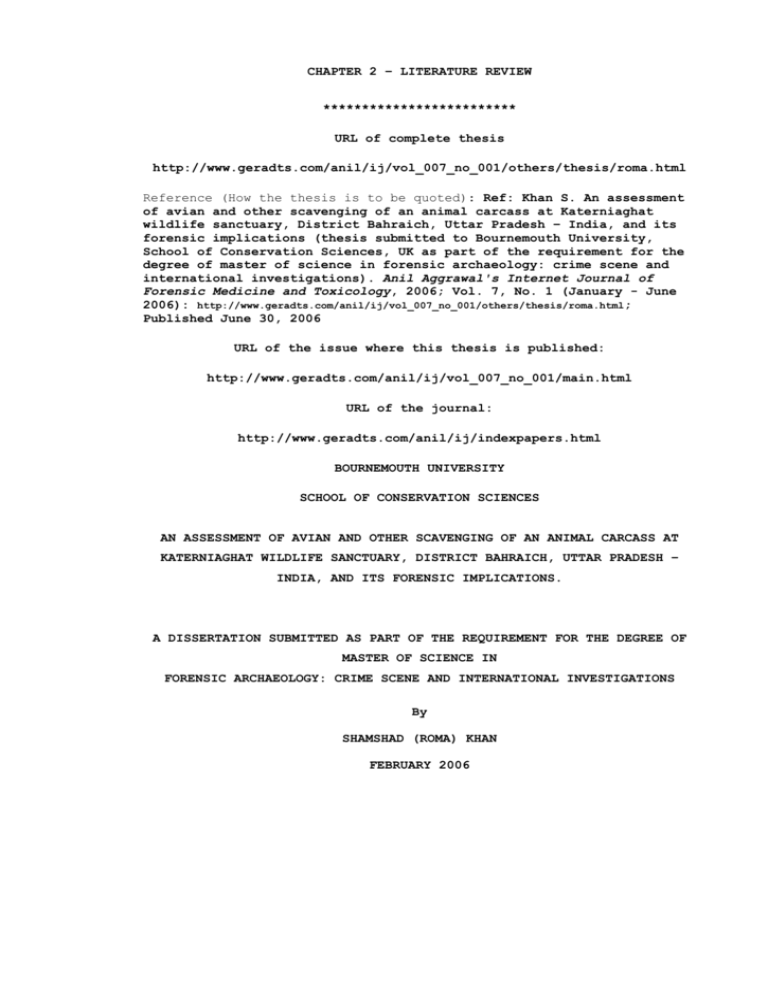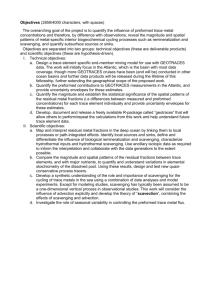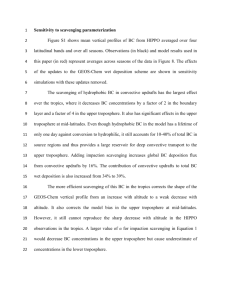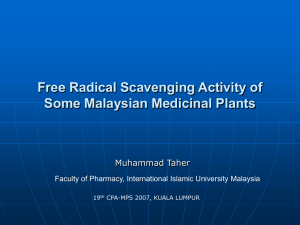bournemouth university - Anil Aggrawal`s Forensic Websites
advertisement

CHAPTER 2 – LITERATURE REVIEW ************************* URL of complete thesis http://www.geradts.com/anil/ij/vol_007_no_001/others/thesis/roma.html Reference (How the thesis is to be quoted): Ref: Khan S. An assessment of avian and other scavenging of an animal carcass at Katerniaghat wildlife sanctuary, District Bahraich, Uttar Pradesh – India, and its forensic implications (thesis submitted to Bournemouth University, School of Conservation Sciences, UK as part of the requirement for the degree of master of science in forensic archaeology: crime scene and international investigations). Anil Aggrawal's Internet Journal of Forensic Medicine and Toxicology, 2006; Vol. 7, No. 1 (January - June 2006): http://www.geradts.com/anil/ij/vol_007_no_001/others/thesis/roma.html; Published June 30, 2006 URL of the issue where this thesis is published: http://www.geradts.com/anil/ij/vol_007_no_001/main.html URL of the journal: http://www.geradts.com/anil/ij/indexpapers.html BOURNEMOUTH UNIVERSITY SCHOOL OF CONSERVATION SCIENCES AN ASSESSMENT OF AVIAN AND OTHER SCAVENGING OF AN ANIMAL CARCASS AT KATERNIAGHAT WILDLIFE SANCTUARY, DISTRICT BAHRAICH, UTTAR PRADESH – INDIA, AND ITS FORENSIC IMPLICATIONS. A DISSERTATION SUBMITTED AS PART OF THE REQUIREMENT FOR THE DEGREE OF MASTER OF SCIENCE IN FORENSIC ARCHAEOLOGY: CRIME SCENE AND INTERNATIONAL INVESTIGATIONS By SHAMSHAD (ROMA) KHAN FEBRUARY 2006 CHAPTER 2 – LITERATURE REVIEW 2.0. Introduction Death is a universal truth. Only the circumstances leading to it differ and these can range from: natural; medical fatalities; accidental; suicides; homicides; mass fatalities; victims of genocide; or war crimes (Haglund, 2001). If an individual dies in any of the circumstances described above, except in a medical facility, they may be found accidentally or deliberately searched for. A corpse may be found indoors, for example, in a house or in an out door situation, such as a field. They may also be found in single or multiple graves (Solla et al., 2003). Such corpses may not only be subjected to natural process of decomposition but will also be a victim to a catalytic process of degeneration brought about by single or multiple scavengers if left undiscovered (Rodriguez et al., 1987; Willey et al., 1989; Hunter et al., 1996; Bass, 1997). A Scavenger is defined as an animal that consume already dead organic life-forms; includes carnivores and omnivores in aerial, terrestrial and aqueous environments (Rebmann et al., 2000) In an outdoor scenario a corpse would be a target for a number of scavengers (Haglund et al., 1996) but there are cases that have been reported where domestic dogs and cats in an indoor context were responsible for post-mortem scavenging of the remains of an individual who died naturally and was not immediately discovered immediately (Iscan et al., 2000). Scavengers could be therefore classified into two types, the first being an obligate or exclusive scavenger and the other being an opportunist scavenger (Ruxton et al., 2004). Among extant vertebrates, only vultures have a diet based exclusively on carrion (Houston, 2001) while, other predatory birds, mammals and reptiles are opportunist scavengers (Ruxton et al., 2004). Faunal scavenger, both obligate and opportunist, consuming corpses are found globally and vary with anthropogenic ecosystem they originate from (Solla et al., 2003). Each independent scavenger is specific in its behaviour and thereby differs from others with respect to preference over food, pattern of scavenging, climate and geographical location (Haglund, 1996). Despite such variations there is commonality within the scavengers: (i) They are responsible for morphological changes of the cadaver (Haglund et al., 1989). (ii) They are responsible for disarticulation and scattering remains of the cadaver (Blumenschine, 1986). (iii) They may inflict confounding post-mortem injuries or trauma either with their beak, claws or teeth on the soft tissue as well as on the bones of the cadaver (Haglund et al., 1988). Consequently, it is of forensic importance to be able to identify the available evidence from these common traits in any death investigations. This chapter focuses on the published literature with regards to scavenging behaviour of various actors. This is divided into: avian; mammalian; and reptilian; with a view, to explore the above commonalities. As the emphasis was on understanding the behaviour of avian and other faunal scavenging, flies and maggots also had their effects on scavenging behaviour of some actors the literature also includes entomology in brief. 2.1. Methods used in literature review In order for any literature review to produce meaningful data and information, it is essential to assess its scientific and intellectual credibility and value. This assessment was carried out systematically and for this reason it was relevant that the method, i.e. systematic search strategy and quality appraisal method, used for the literature review to be presented in this section. This approach to the search strategy and the recording forms are based on models created for standard clinical medicine (Mulrow 1987 and Droogan et al., 1998) and further modified by Whitworth (2003). This is a simplified and limited version of the systematic review process and quality appraisal because this study is not primarily a literature review but an observational study. Throughout the search, the emphasis was placed on peer review published materials. For some information such as maps and information about the location from electronic sources proved beneficial. Details of search engines and other sources used are specified in Appendix 1. This literature review was carried out in two phases, due to the unexpected development during the field observations. For exclusion and inclusion criteria see Appendix 2. All literature identified as including information relevant to this topic were categorised according to research design,(see Table 2.1). Table 2.1. Research designs identified in published materials presented in order of scientific ranking 1. Controlled experiments 2. Experiments without controls 3. Prospective surveys 4. Retrospective surveys 5. Case study a. Multiple case study b. Single case study 6. Discussion 7. Religion For definitions of research design see Appendix 3. Definitions were felt not to be required for ‘case studies’ (multiple and single) and those articles defined as ‘religion’ as they were considered to be explicit. The articles were ranked according to its scientific value, (see Table 2.1). The articles defined as ‘discussion’ and ‘religion’ did not have quality appraisal questions asked of them as they are not answering a scientific question using a scientific method. After the application of the systematic search strategy, the resulting information was deemed credible enough upon which to base the experimental design. Hence it was important for the quality of the material to require appraisal. Quality is an extremely independent opinion and so some degree of impartiality was introduced by asking a series of questions of the papers remaining. The questions used for the quality appraisal for different study types are listed in Appendix 4. 2.2. Types of scavengers and their behaviour Scavenging happens in a sequential order (Brian, 1981). Initial stage begins with removal of soft tissue leading to morphological changes resulting in disarticulation, which in turn produces transportable units of single bones or bone groups influencing the pattern of bone dispersion or scattering (Behrensmeyer, 1982; Crader, 1983). Removal of soft tissues of exposed or partially exposed human remains is brought about by the vertebrate scavengers, such as avian, mammalian or reptilian (Lyman, 1994; Haglund et al., 2001), and succession and colonization of various flies and insects (Dadour et al., 2001). Finally whatever remains is consumed by bacteria and fungi (Lyman, 1994). 2.3. Avian scavenging behaviour In an observational study on avian scavenging, Travaini et al. (1998) used sixteen European hare (Lepus europaeus) carcasses in Argentinean Patagonia and placed them in areas with avian population. The authors observed six avian species feeding on these carcasses, i.e. Chimango Caracara (Milvago chimango), Crested Caracara (Polyborus plancus), Black Vulture (Coragyps atratus), Grey Eagle-Buzzard (Geranoaetus melanoleucus), Red-Backed Hawk (Buteo polyosoma) and Cinereous Harrier (Circus cinereus) which was consumed within two days from the time it was placed. The authors also observed that the Turkey Vultures (Cathartes aura), although abundant, and the Andean condor did not feed on the hare carcasses. The carcasses were predominantly consumed, by Crested and Chimango Caracaras. The other four species of scavengers were observed to consume much smaller proportions. The different birds were seen to consume different parts of the carrion leading to the conclusion that many species of birds may feed together with little competition, because they do not feed on the same kind of flesh within the carcass. Other observational research, looking at the influence of habitat type (wooded, open, or edge) on behavioural responses of avian scavengers (Black Vultures, Turkey Vultures, American Crows (Corvus brachyrhynchos), and Blue Jays (Cyanocitta cristata) was conducted at Gettysburg National Military Park, Pennsylvania, during the winters of 2000 and 2001(Roen et al., 2005). The authors concluded that the Turkey Vultures were more active in wooded habitat than in open and edge habitat, Black Vultures in edge habitat, and American Crows were more vigilant in wooded and edge habitats than in open habitats. 2.3.1. Morphological changes In the absence of exposed trauma, the first target for birds on approaching a carcass is the most accessible part of the soft tissues such as the eyes, nose, mouth, tongue, nipples and anus (Pickering et al 1997; Komar et al. 1998b) or would primarily feed on areas where there is a defect or weakness, such as an abrasion (Komar et al. 1998b). In Tenessee, during an experiment on human remains, a buzzard was seen landing on the chest of the body and proceeded to peck a hole in the abdominal area pulling out the intestines. It then fed on it, leaving the other remains untouched (Bass, 1997). Komar et al., (1998b) observed that crows and magpies penetrated the mummified skin of the carcass creating cavities into the desiccated flesh. Crows and various types of vultures, buzzards and hawks tear the tissues for food, producing furrows in the soft tissue (Attenborough, 1998). Carrion and hooded crows, magpies, gulls, buzzards, kites and golden eagles are attracted to the rotting flesh while blue tits are attracted to the fat (ibid.) of a cadaver. Small birds have been frequently observed on and around decaying human bodies in Tennessee, where they appear to be feeding on the insect larva rather than on the decaying soft tissue (Bass, 1997). Vultures are unusual as they can eat putrid carrion that would poison many other animals (Brooke et al., 1991). Once on the carcass, vultures plant their feet for stability and pull out the flesh with their beaks (Brown et al., 1989). A flock of vultures are capable of rapid and complete defleshing of a freshly killed animal and can strip the soft tissue from a dead body in a few hours (Morse et al., 1983). Black vultures and white-backed vultures are unable to inflict physical damage to bones (ibid), nor do they have the strength to tear the hide of a large animal such as a cow or buffalo, but can thrust their long necks in through the mouth of the carcass and up its anus to rip out the innards (Attenborough, 1998). The turkey vulture’s beak is weak and is not strong enough to rip open hide, and therefore it must wait until decomposition softens the flesh (Plug, 1978). The fastest feeders of the vulture population are the griffons and white-backed vultures (Satheesan, 1998). 2.3.2. Disarticulation and scattering Disarticulation is the anatomical disassociation of bones and involves a spatial separation or scattering (Lyman, 1994). During take-offs and landings the crows and magpies, who possess a formidable wingspan, produce sufficient air displacement to scatter bones from a skeletonized carcass up to a metre, thereby disrupting the appearance of the scene (Komar et al., 1998b). Studies on smaller birds such as common sparrow, robin or blackbird have been documented as removing human hair for use as building and insulation material for their nests (Mann et al., 1990). Locating and searching birds’ nests near a death scene may be useful in securing the deceased’s hair, remains or personal effects (Pickering et al., 1997; Schmitt 2002; Benson et al., 2004). Birds may also take shiny objects such as jewellery (Pickering et al., 1997) and small bits of clothing (Killam, 1990). Birds have demonstrated the ability to move substantial objects particularly ribs and fragmented cranial and facial bones (Komar, et al., 1998b). During an observational study by Komar et al. (1998b) a crow was seen flying away, carrying a plastic credit card in its bill which had been placed in the rear trouser pocket of the specimen’s clothing. The card was recovered from the ground at a distance of forty metres away from the carcass (ibid). Vultures play some role in scattering and loss of bones (Plug, 1978; Krogman et al., 1986), for example, the Lammergeier vulture, found in countries such as, Spain, Greece, Corsica, Albania, Morocco, Tibet, India and Turkey, can carry almost the whole skeleton of a mountain goat up into the sky rising up to 150 metres before dropping it onto the rocks below and then feeding on the marrow freed from the shattered bones (Austin, 1962). 2.3.3. Post-mortem artefacts and scavenging trauma Lesions inflicted by carrion-feeding birds such as vultures, owls, buzzards or seagulls, and described in the literature are usually stab-like puncture wounds caused by their hard, sharp bills (Solla et al., 2003). In 1898, Vonn Hoffman described wounds inflicted by the impact of chicken bills on the corpse of a child found under a tree (Roll et al., 1991). They were observed as multiple, parallel lesions, and sharp marginal slits of three to four millimetre long (Roll et al., 1991; Solla et al., 2003). The pecking and tearing action used in their feeding produces small strips of adherent tissue which has a sinewy type appearance (Rodriguez et al., 1987). Damage to the bones comes from their beaks and sharp talons (Roll et al., 1991). The structure of chicken bills has been shown to create distinctive lesion patterns which are identifiable (Bovey, 1990). Injuries to the soft tissue by crows appear as small triangular shaped punctures resulting from pecking with the beak (Rodriguez et al., 1987). These birds also tear skin in sheets, leaving straight edges in the remaining tissue which resembles cuts (Komar et al., 1998b). Black vultures are known to damage the craniums of small animals with their beaks (Brian, 1981). Buzzards and vultures are excellent scavengers, often completely defleshing a corpse in a matter of few hours (Pickering et al., 1997). Egyptian vultures prefer to feed on tough tissues such as tendons, cartilage bone pieces and skin in addition to maggots, whereas bearded vultures feed mainly on bones (Satheesan, 1998). Surgical-like cut marks due to hawk and vulture scavenging on pig carcasses have also been reported (France et al., 1996). These beak marks are present in the centre of a large bone surface area, such as the shaft of long bones or the flat portions of irregular bones such as the scapulae and innominates (Komar et al., 1998b). 2.4. Mammalian scavenging behaviour Animal scavenging, in relation to decomposing remains is an area where interest has grown (Haglund et al., 1996). A survey of domestic and wild carnivore mammals such as dogs, large cats, rodents, marine animals, bears, horses and cows has been summarized by Iscan and McCabe (2000) who discuss the injuries and behaviours of these animals. The effects of wild animals on archaeological human remains have been observed extensively (Miller, 1969; Krogman, 1970; Sutcliffe, 1973; Miller, 1975; Brothwell, 1976; Galdikas, 1978; Morse, 1983; Haglund et al., 1989; Asamura et al., 2004). Several authors have evaluated the impact of rodent gnawing upon human bone, primarily in a forensic context (Snow et al., 1984; Hoffman et al., 1987; Haglund, 1992; Owsley, 2001; Patel, 1994; Haglund, 1996). 2.4.1. Morphological changes Lyman (1994) suggests that scavenging begins at the point of most accessibility to the carcass. A high percentage of soft tissue loss was recorded due to scavenging by domestic animals, such as dogs and cats, in the areas of the carcass that were left exposed (Abler, 1985; Tsokos et al., 1999). These studies were in contrast with the established anthropological research that states that most animals have an established order of scavenging, beginning at the body area with highest nutritional value (Rackham, 1994). A case from Tennessee shows that despite the body being fully clothed and exposed for only two days, scavenging dogs not only opened the thoracic and abdominal cavities, devouring the internal organs but also destroyed the meaty portions of the arms along with the neck and face (Willey et al., 1989). Post-mortem trauma due to bear scavenging is primarily directed at the head, and then the neck (Carson et al., 2000). In an investigation carried out on captive wolves and road killed deer by Iscan and McCabe (2000), the authors noticed that the animals are first interested in open wounds or blood oozing, as in the area of nose or mouth, licking and chewing continuing to scavenge over several days. It is known that wild dogs have a tendency to attack or scavenge in packs causing post-mortem mutilation to human remains (Kneafsey et al., 1995). A concise overview of species and the preferred part or parts of the body targeted can be found in Table 2.2. Table 2.2: An overview of species and the preferred part(s) of the body targeted. Species Preferred body part(s) targeted Dogs Soft tissue from limbs, neck and face, internal organs Cats Exposed areas of the body Bear Head and neck Wolves Open wounds, licking blood from nose or mouth Rodent Forehead, nose, lip, eyes, soft tissues from the face Rodent scavenging has been mistaken for scalping injury in a case where the female’s face showed an extensive soft-tissue wound of the forehead, nose and upper lip (Iscan et al., 2000). In an anecdotal report, all soft tissues of the face and neck of the human corpse, including both eyes had been eaten away by rats (Haglund, 1992). 2.4.2. Disarticulation and scattering Scavenging can result disarticulation (Haglund et al., 1989). The investigation of scattering and damage to skeletons by animals may aid in establishing the post-mortem interval (Morse et al., 1983) and it may also reflect ecological and environmental conditions under which disarticulation occurred (Rhine et al., 1988; Brian, 1981). A general scheme of scavenging and disarticulation for African prey by a variety of animals such as hyenas, dogs and large cats has been proposed by Blumenschine (1986). Haynes (1980) and Binford (1981) provided information about artiodactyl carcasses fed upon by various carnivores, most notably wolves (Willey et al., 1989). As consumption progresses, the body becomes disarticulated with the most easily transportable portions removed first (Solla et al., 2003). For example, the most frequently observed articulating anatomical components from carcasses which have been scavenged are the: head with the atlas and axis; the rib cage with some cervical and thoracic vertebrae, including the sternum; the scapulae and upper extremities; and the lumbar vertebrae, pelvis and lower extremities, particularly the tibia and fibula (Haynes, 1982; Haglund et al., 1989), see Figure 2.1. This suggests that the carcasses utilized by larger scavengers are taken apart in predictable patterns which make certain groups of bones available for transport together (Haglund et al., 1989). head + atlas and axis scapulae + humerus + radius and ulna cervical vertebra + rib cage + sternum + thoracic vertebra lumbar vertebra + pelvis + femur + tibia and fibula Figure 2.1: Illustration of the most frequently observed articulating anatomical components from a human skeleton to be scavenged (adapted from Cull, 1989) 2.4.3. Post-mortem artefacts and scavenging trauma Destruction by carnivores such as, dogs, cats, wolves, bears, to name a few, is characterized by V-shaped puncture marks from canine teeth and claw abrasions and the damage consists of extensive bone splintering and crushing (Iscan et al., 2000). Cancellous portions are the first areas targeted (Morse et al., 1983). Three basic types of wounds from carnivores are: crush wounds, which splinter bone, puncture (stab) wounds, from the animal’s sharp canines and avulsion wounds, which tear tissue and are created by the animal shaking its head (Iscan et al., 2000). Large cats, canids, bears and hyenas create distinctive types of damage when they gnaw bones (Haynes, 1983). Haynes (1983) provided a comparison of general characteristics of gnaw damage caused by different carnivores which may be helpful in identifying individual carnivorous species. A concise overview of species and the trauma caused on remains can be found in Table 2.3. Table 2.3: An overview of species and the trauma caused on remains. Species Trauma caused on the remains Dogs V-shaped puncture marks, bone splintering and crushing Large Cats V-shaped puncture marks, bone splintering and crushing, gnaw marks Bear V-shaped puncture marks, bone splintering and crushing, gnaw marks Wolves V-shaped puncture marks, bone splintering and crushing Rodent Parallel furrows, gnaw marks Rodent gnawing has been discussed extensively by others (Morse et al., 1983; Mann et al., 1990; Haglund, 1992; Patel, 1994; Ropohl et al., 1995). Rodent gnawing may be differentiated from carnivorous activity by the characteristic parallel furrows created by the large chisel like incisors (Haglund, 1988). In contrast to this Miller (1975) suggested that the incisors of canids such as coyotes and wolves can cause hollow grooves which can mimic the gnawing marks of rodents. Multiple gnawing may present as a series of parallel marks, fan-shaped patterns or totally disorganized striations overlying each other (Shipman et al., 1982). On soft tissues, rodent tracks can be identified by crenulations and a layered demolition of the tissues (Haglund, 1992). Postmortem features that distinguish animal scavenging are affected by the dental structure of the animal, mastication power, feeding behaviour and the tissue targeted (Solla et al., 2003). 2.5. Reptilian scavenging behaviour To date, there is a dearth of literature showing any evidence of scavenging by reptiles. The notion of scavenging by crocodiles, alligators (Iscan et al., 2000) and snakes (DeVault et al., 2002), such as the giant constricting snakes of the Boidae family, has been rejected or ignored as they are generally considered to be predators (Alderton, 1991). The searches executed brought forth information, which may be indirectly useful regarding these species. There are 23 living crocodilian species recognised and are found in over 90% of the world's countries and islands (Ross, 1989). Crocodiles are generally found in the tropical regions, being unable to survive and reproduce successfully in cold climates (Steel, 1989). Alligators are found almost exclusively in North, Central and South America, the sole exception being the Chinese alligator which is found in eastern China (Webb et al. 1987). The single member of the family Gavialidae (Indian gharial) is found in India, Bangladesh, Bhutan, Myanmar, Nepal and Pakistan (Ross, 1989). Crocodiles and alligators cause considerable injury and fatality (Iscan et al., 2000). Of the two reptiles, crocodile is the larger and the injuries it causes are more often fatal. 2.5.1. Morphological changes Authenticated reports of four human deaths in the United States by constricting snakes showed that the animal kill by first securing their prey, by biting and then wrapping its coils around the victim and constricting until the prey ceases to live (Iscan et al., 2000). Most species of snakes readily accept carrion in captivity and may use scavenging as a deliberate feeding strategy that supplements their regular modes of prey acquisition (DeVault et al., 2002). This raises the possibility of these reptiles being opportunist scavengers. Predatory behaviour is well documented as reports about crocodile attacks and fatalities across the globe. In a report, in Trinity Hospital, a district hospital in the south of Malawi, over a period of four years 60 patients were admitted following injury by crocodiles (Vanwersch, 1998). All patients were treated by extensive surgical cleaning and debridement, anti-tetanus treatment and broad spectrum antibiotics. Twenty-four patients (40%) had serious injuries resulting in permanent deformity. Only one patient died from sepsis. In Korogwe district in Tanzania crocodiles were responsible for 51 deaths from January 1990 to April 1994 (Scott, 1994). Of these, 18 deaths occurred in the first four months of 1994. There were 16 reported crocodile attacks in Northern Territory waters in Australia, from June 1981 to June 1991, four of these were fatal (Mekisic et al., 1992). From 1948 to August 1, 2004, 376 injuries and 15 deaths have been reported in United States as a result of encounters with alligators and crocodiles (Langley, 2005). These were just a few of those reports with regards to fatal crocodile attacks. All these instances show the predatory behaviour of crocodiles. 2.5.2. Disarticulation and scattering Crocodiles usually catch their prey and rotate until part of the body of the victim, such as the head or appendages, is dismembered from the rest of the body (Iscan et al., 2000). These animals generally pull their prey into the water (ibid) and swallow their food as a whole without chewing (Whitakar et al., 1983). No literature identified to contribute direct or indirect evidence regarding disarticulation due to alligators or snakes interventions. 2.5.3. Post-mortem artefacts and scavenging trauma As mentioned above, between 1978 and 1989, four human deaths were reported in United States caused by constricting snakes (Iscan et al., 2000). The authors found that, the dentition of the reticulated python (Python reticulates) consisted of two parallel rows of numerous curved homodont teeth in the maxilla and one row in the mandible. Wounds caused by these teeth were small punctures arranged in a linear and parallel fashion and the bite marks were readily observed on the face and neck of one of the four confirmed victims (ibid). From 1981 to 1991 in Australia, of the sixteen crocodile attacks in total (Mekisic et al., 1992), the authors reported that the injuries in the twelve survivors ranged from minor lacerations and puncture wounds to major abdominal, chest and limb trauma. Death in fatal attacks was caused by transection of the torso or decapitation. In crocodiles, the fourth tooth in the lower jaw is accommodated in a notch in the upper jaw and is visible when the mouth is closed (Ross, 1989). The crocodile’s teeth are designed to seize and hold prey, not to chew (ibid). Crocodiles swallow their food whole if it's small enough but uses their powerful teeth and jaws to crush and break up larger prey or to splinter the hard outer shell of a crab or a turtle (Webb et al., 1987). Nile crocodiles eat buffaloes and occasionally people (Whitakar 1983). 2.6. Insect activity After death the human body undergoes a series of decompositional stages, with characteristic insect species being associated with each (Rodriguez et al., 1983). Flies locate a corpse after death and feed upon exudates. They oviposit, eggs into the natural body openings of the corpse and or at wound sites (Henssge et al., 1995) hatching out as maggots and pass through different stages of development whilst consuming the soft tissue. It eventually develops into pupae, whereupon the adults emerge, thus completing the cycle (Micozzi, 1986; Campobasso et al., 2001). The cadaver can be colonized by a variable number of arthropods belonging to different taxa, each characterizing different stages of soft tissue decomposition (Rodriguez et al., 1987) fresh, bloated, decayed and dried, as defined by Reed (1958). Forensic Entomology exploits this natural process of decomposition in order to obtain information regarding manner of death, possible corpse movement after death, identify drug use in heavily decomposed bodies, how long a child or patient had been neglected, link suspects to crime scenes, determine the immediate conditions at the time of death, and most commonly, estimate the Post Mortem Interval (Bass, 1997). Influence of insect colonization of the cadaver accelerates the consumption of organic matter (Micozzi, 1991; Shean et al., 1993; Bass, 1997; Compobasso et al., 2001). The majority of soft-tissue destruction is due to feeding by insect larvae (Mann, et al., 1990).







